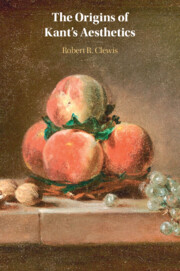Book contents
- The Origins of Kant’s Aesthetics
- The Origins of Kant’s Aesthetics
- Copyright page
- Dedication
- Contents
- Figures
- Acknowledgments
- A Note on Citations
- Abbreviations
- Introduction
- Part I Aesthetic Judgment and Beauty
- Part II Genius and the Fine Arts
- Part III Negative and Positive States
- 6 Meet the Sublime Now: It’s a Negative Pleasure
- 7 Ugliness and Disgust: Disagreeable Sensations
- 8 Playing with Humor
- Closing Reflections
- Bibliography
- Index
6 - Meet the Sublime Now: It’s a Negative Pleasure
from Part III - Negative and Positive States
Published online by Cambridge University Press: 10 January 2024
- The Origins of Kant’s Aesthetics
- The Origins of Kant’s Aesthetics
- Copyright page
- Dedication
- Contents
- Figures
- Acknowledgments
- A Note on Citations
- Abbreviations
- Introduction
- Part I Aesthetic Judgment and Beauty
- Part II Genius and the Fine Arts
- Part III Negative and Positive States
- 6 Meet the Sublime Now: It’s a Negative Pleasure
- 7 Ugliness and Disgust: Disagreeable Sensations
- 8 Playing with Humor
- Closing Reflections
- Bibliography
- Index
Summary
Chapter 6 characterizes the development of Kant’s views of the sublime in Observations on the Feeling of the Beautiful and Sublime and other pre-Critical writings and materials. The description of the sublime in the third Critique is shaped by Kant’s moral turn and his interest in a principle of natural purposiveness. The chapter shows how the early Kant synthesizes the ideas of Edmund Burke on the one hand and Alexander Baumgarten and Moses Mendelssohn on the other. It reveals how Kant shifts from a psychological–anthropological account of the sublime to a non-empirical, transcendental one.
- Type
- Chapter
- Information
- The Origins of Kant's Aesthetics , pp. 151 - 178Publisher: Cambridge University PressPrint publication year: 2023

